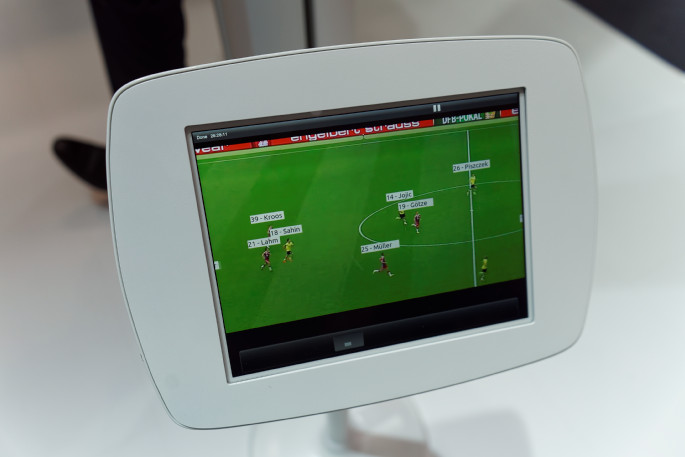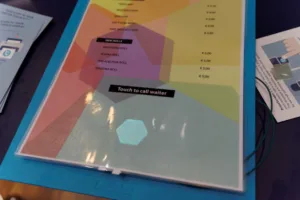We would have liked more time to get around Hall 9, which is devoted to new technologies and R&D. If you are a real technology geek, almost every item could be of some interest. The demonstrations highlight the strength of R&D in Germany.
University of Saarland Strong on Visual Computing
We spoke first to three groups from the University of Saarland, which has strong display-related interests – we have written before about the Visual Computing Institute that is working with Intel on “Display as a Service”.
Saarland Menu with printable EL allows the hexagonal touch display element at the bottom of this menuThe first group has been looking at developing low cost and low volume simple display fabrication processes. It is using EL inks (from Gwent in the UK) to create the display surface which is then touch-enabled, allowing the development of low cost custom displays. The patterns for the four display layers are created using standard vector-based PC software such as Adobe Illustrator, and then deposited using screen printing (although we noted that the group’s literature also made reference to inkjet printing of the patterns). Patterns can be segmented, multi-segmented or even passive matrix layouts.
The substrate used can be paper or PET, but also unconventional materials such as leather, stone, wood or metal.
The display electrodes can also be used for simple touch control to allow displays to be used as touch switches.
For the group, the key to this development is very low cost and easy to use technology so that very low numbers of very simple displays can easily be created, perhaps by “print shops”. A barrier to many of these applications is the junction between the hard world of silicon and the flexible world and we heard that this is often the case in flexible and printed electronics. There is good work going on either side of the connection, said the group, but sometimes how to make the connection efficiently is not clear.
Gaze is Used to Scroll Text for Multiple Readers
The next group we spoke to is looking at using gaze control to control text display rates. We put on the eye-tracking glasses and tried the system. As well as looking at the simple tracking, the group has been working on how to allow multiple users to look at the same display and scroll different columns of text, or parts of the columns of text at the same time. The software divides text columns into functional blocks and as the eye moves towards the top or bottom of the block, scrolling of the text happens as though the block was a window onto the text.
The text scrolling speed is calculated by watching the movements of the eye and computing an average so that the appropriate scrolling speed can be maintained. The ultimate concept of the research is to allow multiple users to access displays and each be presented with the right reading material at the right speed. At present, the system can support three independent readers.
Contact [email protected] for more information.
Analyst Comment
This editor’s enthusiasm for gaze is well known – and controlling reading speed was one of the useful applications that is being developed. However, I found it very disconcerting that the text that I was focused on was moving when the display scrolled. The scrolling was not very smooth and I was trying to read German, which I am weak at, and these are both factors that could have made the task more difficult. I also wonder how soon it would be that we have sensor technology that is accurate enough to estimate the gaze from multiple viewers at long distances without calibration. Even though I was using a head-mounted gaze tracker, it took two calibration attempts before I could get the system to work. (BR)
Smartphones and Tablets are Bad for your Health
The third group from the University was looking at problems in posture and health caused by the over use of tablets and smartphones. Users of these devices tend to adopt a very bad posture with the head tipped very far forward. A study of 40 users showed that just two of the forty had their heads held upright in a way that would not cause neck discomfort and potential damage. One solution to this is to encourage users to hold their devices higher up, but this, in turn leads to musculo-skeletal problems in the shoulders and back.
The researchers have developed a tool, based on 3D capture and biomechanical simulation, to help system designers to understand the effects on the user of prolonged use of these devices, and of touch screens in general. With this knowledge, system designers can monitor the user and “nudge” the user to change position and move to counter the potential of RSI injuries.
Fraunhofer Shows Player Recognition
 The Fraunhofer HHI from Berlin has moved forward from the “virtual camera” technology that it was showing at IFA. The group is developing technology to allow windows within a very high resolution video image (8K Super Hi-vision or more) to be selected and which can track either viewer’s (or director’s) viewports or can also be programmed to follow individual players in sports (the example was being shown of a player being tracked during a soccer match).
The Fraunhofer HHI from Berlin has moved forward from the “virtual camera” technology that it was showing at IFA. The group is developing technology to allow windows within a very high resolution video image (8K Super Hi-vision or more) to be selected and which can track either viewer’s (or director’s) viewports or can also be programmed to follow individual players in sports (the example was being shown of a player being tracked during a soccer match).
The HHI has now further developed the technology to allow the idenitification of individual players within a window and was showing a viewport with named players at the show.
Contact [email protected]

